Advanced Sonata Goes High-tech with Hybrids
By John Gilbert
The 2011 Hyundai Sonata was a breakthrough vehicle for the South Korean manufacturer, proving it could out-flank even the Japanese for such technical assets as dramatic contoured styling, a world-class engine with variable valve-timing and other-worldly direct injection, and a new home-built transmission.
Cutting-edge technology, to be sure, but cutting-edge mainstream stuff. Hyundai improved on that model with the 2015 Sonata, but even those advancements couldn’t prepare us for the high-tech leap to the 2016 Sonata Hybrid and Plug-in Hybrid models.
Discussing technical assets can make consumers, and some journalists, take on a glazed-over gaze, but all the technology would be meaningless if the Sonata — or any hybrid — didn’t approach normal-driving capabilities. In that regard, the 2016 Sonata Hybrid sets new standards.
You might even think you’ve gotten in the wrong car when you select “Sport” from the three drive modes, then manually command the Shiftronic transmission to rally the combined forces of the gas-engine and electric-motor and transmission for surprising potency.
“Our development goal was to combine the features of economy and fun-to-drive,” said Yong-Seok Kim, project manager for the Sonata Hybrid. “you can set the manual shift mode for Eco, Norm, or Sport. Our research shows that 45 percent drive in Economy, 35 percent in Normal, and 20 percent drive aggressively.
“With our selective control, you can set it for whichever style you want, then adapt, or let the car adapt to you. We’ve reduced the gap between driving and aggressive driving. Whichever way you drive, as you come up to a stop light and release the gas pedal to coast, you can reduce your fuel consumption by 3 percent.”
Without question, first drives of the Sonata Hybrid on the Los Angeles freeways and through the hills around Los Angeles, proved that the car’s performance is easily as good as the hottest-performing Sonatas.
The hybrid models are virtually a separate class from the normal Sonatas. You can choose a base Sonata Hybrid for $26,000, and add features and capabilities to rise to the Limited, or go upward again to reach the Limited Ultimate.
There are more differences between the Hybrid and the Plug-In Hybrid than merely using Clean and informative dash layout shows current fuel economy over 54 mpg in the Sonata Hybrid.plug-in power to fully recharge, and the Plug-in Hybrid starts at $30,100 as a Limited model, moving up to Limited Ultimate for an extra $4,500. Those prices are only moderately more expensive than the non-hybrid Sonata, and they can fetch you a $4,919 tax credit as well.
While the normal Sonata does well with engines ranging from the 2.4 to the 1.6, including a 2.0-liter turbo, the hybrids make use of the same engine, a newly refined 2.0-liter without the turbocharger.
All hybrids depart from the normal Sonata’s styling, with a more aggressive front grille opening, and revisions to the headlight and taillight housings to aid fuel-economy. In the process, the Sonata Hybrid winds up with a segment-best 0.24 coefficient of drag, lowered from the normal Sonata’s 0.27. Fuel economy can venture beyond the EPA estimated 40-44 miles per gallon highway, by altering heavy-footed driving habits.
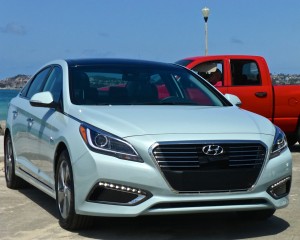
Sonata Hybrids come in Base or Limited, and the plug-in version offers increased power and capability.
By cheating to overuse electric-only power when fully charged, we started out registering 99.9 miles per gallon — because the gadget wouldn’t measure three digits. Continuing beyond about 24 pure-electric miles, we still averaged 68.8 mpg for the first leg. My partner, whose right foot always seems closer to the floor, reached as high as 59.6 mpg at a sustained 70 miles per hour.
The current Sonata had a hybrid model, but it wasn’t about to challenge the industry leading hybrid sedans from Toyota or Honda. The new car challenges everything on the market. To start with, Hyundai will aim sales at the West Coast, where there are an abundance of quick-charge stations. But buyers farther inland can order the Hybrid or Plug-in Hybrid and find their own way to capitalize on all the features.
The secret of advancing hybrid technology is that car companies aren’t in the battery-making business, so coordinating with battery companies is vital. Hyundai has a fellow-South Korean ally in LG Industries, and a newly created LG Lithium-polymer battery pack feeds Sonata’s permanent magnetic synchronous motor and clutch arrangement, with is located where the 6-speed automatic transmission’s torque converter normally would be. That unique coupling is the ideal way to blend the electric power with that new 2.0-liter gas 4-cylinder engine.
Taking away the turbo reduces the power of the normally-aspirated 2.0, but it gets more than sufficient power with the added power surge from the electric motor. In fact, the power assist comes in two doses, depending on whether you have the normal or the plug-in hybrid.
The 2.0 gas engine by itself has 154 horsepower peaking at 6,000 RPMs, and 140 foot-pounds of torque at a high 5,000-rev peak. The LG battery unit with its vertical plates in a more compact alignment, adds 51 horsepower from a 1,770-2,000 RPM peak in the Hybrid, or 67 added horsepower from 2,330-3,330 RPMs in the Plug-in Hybrid. Both benefit from the boost of 151 foot-pounds of torque from the electric motors, which operate at that peak all the way from 0-1,770 RPMs.
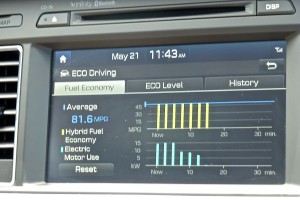
Alterations to the 2016 Sonata Hybrid are more attractive with the chance to beat 50 miles per gallon.
Doing the math, the Sonata Hybrid has 193 horsepower, and the Plug-in Hybrid has 202 horsepower. A larger battery pack is needed for the added power, and that boosts the weight of the Hybrids (3,497-3,560 pounds) to the Plug-in’s 3,787-3,810 pounds. But starting out in the morning with a full charge means you can drive the full 24 miles on pure electric, which exceeds the prime contenders, the Fusion Energi and the Accord plug-in hybrid.
Getting to that full charge offers an interesting choice, too. If you plug into a normal household outlet of 110/120 volts (Level 1), you’ll need 9 hours to reach full charge. If you have the 220/240 Level 2 outlet, you can reach full charge in only three hours. Using the normal internal charging system that takes power from the gas engine and regenerative braking means an owner could drive the Sonata Hybrid “normally” and not realize it’s a hybrid from performance, unless the over-40 mpg made the driver curious.
Hyundai’s John Shun, who oversees Sonata Hybrid production, said, “You can maximize miles per gallon over fun-to-drive, or vice versa. For example, in Sport, you get immediate throttle response, in Normal you get normal response, and in Eco, there’s more hesitation when you use regular throttle pressure.”
For the curious, you can coax the Sonata Hybrid up to 75 miles per hour on pure electric, although that might drain the battery’s power quicker. Shun said all the latest safety tricks are on the Sonata Hybrids, including blind spot detection, lane departure warning, a rear parking sensor, and forward collision warning, and so anxious are Hyundai engineers to make the Sonata safe, a “virtual” engine sound system will be coming next, to alert pedestrians who might not hear the electric-powered hybrid approaching while doing their text-walking maneuvers.
Other neat features include a 5-inch touchscreen and an 8-speaker audio, an upgraded 8-inch screen and a 9-speaker, 400-watt audio, or an electroluminescent instrument light show that can replace the tachometer with a power-consumption gauge, and includes a 4.2-inch trip computer. Buyers can choose an energy gauge that indicates battery charge, range, and the energy flow the way you are currently driving, and with the Blue-link smart-phone app, you can seek out high-speed charging stations.
In the rear, the Sonata boasts of being the only midsize hybrid with a flat cargo floor. Combined with the split fold-down rear seat, cargo volume reaches 13.3 cubic feet, decreased to 9.9 with the larger battery in the Plug-in. Those things might be more important in marketing than such items as the motor-driven, RPM-sensing, rack-and-pinion power steering.
But with the 2016 Sonata Hybrids, buyers have to accept both — creature features and high-technology advances.


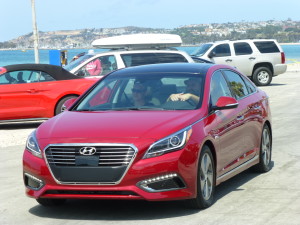
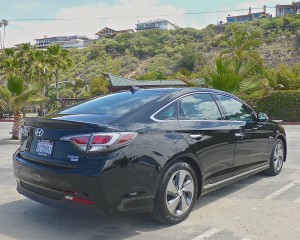
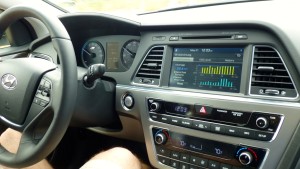
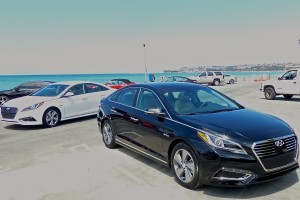
 John Gilbert is a lifetime Minnesotan and career journalist, specializing in cars and sports during and since spending 30 years at the Minneapolis Tribune, now the Star Tribune. More recently, he has continued translating the high-tech world of autos and sharing his passionate insights as a freelance writer/photographer/broadcaster. A member of the prestigious North American Car and Truck of the Year jury since 1993. John can be heard Monday-Friday from 9-11am on 610 KDAL(www.kdal610.com) on the "John Gilbert Show," and writes a column in the Duluth Reader.
John Gilbert is a lifetime Minnesotan and career journalist, specializing in cars and sports during and since spending 30 years at the Minneapolis Tribune, now the Star Tribune. More recently, he has continued translating the high-tech world of autos and sharing his passionate insights as a freelance writer/photographer/broadcaster. A member of the prestigious North American Car and Truck of the Year jury since 1993. John can be heard Monday-Friday from 9-11am on 610 KDAL(www.kdal610.com) on the "John Gilbert Show," and writes a column in the Duluth Reader.